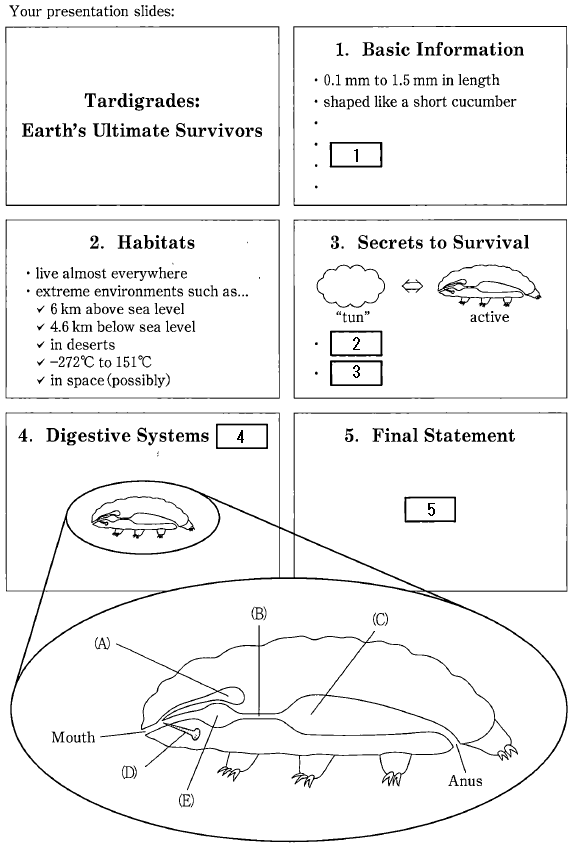
問1 Which of the following should you not include for ( 1 )?
① eight short legs
② either blind or sighted
③ plant-eating or creature-eating
④ sixteen different types of feet
⑤ two stylets rather than teeth
問2 For the Secrets to Survival slide, select two features of the tardigrade which best help it survive. (The order does not matter.) ( 2 )( 3 )
① In dry conditions, they metabolism drops to less than one persent of normal.
② Tardigrades in a state of tun are able to survive in temperatures exceeding 151℃.
③ The state of tun will cease when the water in a tardigrade's body is above 0.01%.
④ Their shark-like mouths allow them to more easily eat other creatures.
⑤ They have an ability to withstand extreme levels of radiation.
問3 Complete the missing labels on the illustration of a tardigrade for the Digestive Systems slide. ( 4 )
① (A) Esophagus(B) Pharynx (C) Middle gut (D) Stylets (E) Salivary gland
② (A) Pharynx (B) Stylets (C) Salivary gland (D) Esophagus(E) Middle gut
③ (A) Salivary gland (B) Esophagus (C) Middle gut (D) Stylets(E) Pharynx
④ (A) Salivary gland (B) Middle gut (C) Stylets (D) Esophagus (E) Pharynx
⑤ (A) Stylets (B) Salivary gland (C) Pharynx (D) Middle gut (E) Esophagus
問4 Which is the best statement for the final slide? ( 5 )
① For thousands of years, tardigrades have survived some of the harshest conditions on earth and in space. They will live longer than humankind.
② Tardigrades are from space and can live in temperatures exceeding the limits of the Arctic fox and Bactrian camel, so they are surely stronger than human beings.
③ Tardigrades are, without a doubt, the toughest creatures on earth. They can survive on the top of mountains; at the bottom of the sea; in the waters of hot springs; and they can also thrive on the moon.
④ Tardigrades have survived some of the harshest conditions on earth, and at least one trip into space. This remarkable creature might outlive the human species.
問5 What can be inferred about sending tardigrades into space?
① Finding out whether the tardigrades can survive in space was never thought to be important.
② Tardigrades, along with other creatures that have been on earth for millions of years, can withstand X-rays and ultraviolet radiation.
③ The Israeli researchers did not expect so many tardigrades to survive the harsh environment of space.
④ The reason why no one has been to see if tardigrades can survive on the moon's surface attracted the author's attention.
【正答】
問1 ④ 問2 ①⑤ 問3 ③ 問4 ④ 問5 ④
出典:共通テスト本試験2023 - 大問6B【日本語訳】

問1 次のうち,( 1 )に含められないものはどれか?
① 8本の短い足
② 目が見えないか見える
③ 草食または肉食か
④ 16の異なるタイプの足
⑤ 歯ではなく2本のスタイレット
問2 「生存の秘密」のスライドで,クマムシの生存に最も役立つ特徴を2つ選びなさい。(順は問わない)( 2 )( 3 )
① 乾燥した状態では,代謝が通常の1%未満に低下する。
② ツンの状態のクマムシは,151℃を超える温度でも生き残ることができる。
③ クマムシの体内の水分が0.01%を超えると,ツンの状態は終了する。
④ サメのような口により,他の生き物をより簡単に食べることができる。
⑤ 極端なレベルの放射線に耐える能力を持っている。
問3 消化器系のスライドのクマムシのイラストのラベルの欠落を埋めなさい。( 4 )
①(A)食道(B)咽頭(C)中腸(D)スタイレット(E)唾液腺
②(A)咽頭(B)スタイレット(C)唾液腺(D)食道(E)中腸
③(A)唾液腺(B)食道(C)中腸(D)スタイレット(E)咽頭
④(A)唾液腺(B)中腸(C)スタイレット(D)食道(E)咽頭
⑤(A)スタイレット(B)唾液腺(C)咽頭(D)中腸(E)食道
問4 最後のスライドで,最も適切な説明文はどれか?( 5 )
① 何千年もの間,クマムシは地球上と宇宙で最も過酷な条件のいくつかを生き延びてきた。彼らは人類よりも長く生存するだろう。
② クマムシは宇宙からやってきて,ホッキョクギツネやフタコブラクダの限界を超える温度で生きることができるので,人間より強いのは確かだ。
③ クマムシは間違いなく地球上で最もタフな生物だ。彼らは山の頂上や海の底,温泉水の中で生存でき,月面でも繁栄できる。
④ クマムシは,地球上で最も過酷な条件のいくつかと,少なくとも1度の宇宙旅行を生き延びた。この驚くべき生物種は,人類よりも長く生存するかもしれない。
問5 クマムシを宇宙に送り出したことについて,何が推測できるか?
① クマムシが宇宙で生き残れるかどうかを調べることは,重要だとは考えられていなかった。
② 何百万年もの間地球上に存在する他の生物と同様に,クマムシはX線や紫外線に耐えることができる。
③ イスラエルの研究者は,宇宙の過酷な環境でこれほど多くのクマムシが生存できるとは予想していなかった。
④ クマムシが月の表面で生き残ることができるかどうかを誰も見たことがなかった理由が,著者の注意を引いた。

